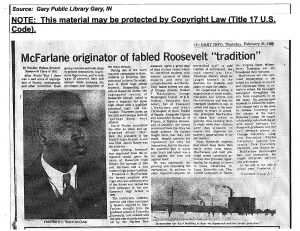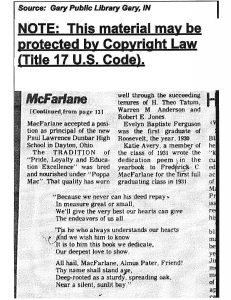Roosevelt Alumni Timeline
In 1907 William Wirt came to Gary as its first Superintendent of Schools. Although he had been known as a progressive educator, he went along with the Gary Board of Education in the 1908 decision to segregate the public schools in Gary. His acceptance of a “separate but equal” school system helped place the Negro citizens of Gary into its lowest social strata.
The first primary school for Negro students was erected at 12th Avenue and Massachusetts the same year the city’s school board made the decision to segregate its public schools. The primary school had several locations on the East and West side of Gary that were known as, “Negro Primary” school buildings. The 15th Avenue and Virginia Street schools enrolled Negro, Primary and Secondary students. It had overcrowded and substandard facilities. There was another school for Negroes at 14th and Connecticut; the school board moved the two schools to Friedrich Froebel School at 15th and Madison. To meet the demands of a growing Negro population another primary Negro school was open in 1915 at 21st Avenue and Adams. Children were then transferred from Froebel to the Adams Street location.
In A letter written by John H. Smith, a genealogist, to the Gary Daily Tribune in January 1921 he praised the Colored teaching staff for providing excellent instructions and “In fact” ” there are no segregated schools in Gary, only so far as the parents of the children choose to make it. There is nothing to prohibit White or Negro children from going to any of the schools… it is only a matter of race pride on the part of the parents of each race.”
While voluntary segregation was prominent, civil rights activists in the city continued to protest such conditions. In April 1921, a visit from Dean William Pickens, NAACP’s associate field secretary, met with Superintendent Wirt and Gary Land Company’s H.S. Norton. He elicited statements from both their commitment to Gary NAACP that “the foundation has been firmly laid for eliminating any prejudice that might have existed.”
They were referring not to the demise of segregation, but to the attempt to provide somewhat equal facilities and opportunities for Negroes, such as the “Negro trade school” established at the 25th Avenue school, which epitomized school segregation. ‘The origins and development of the trade school are indicative of how far segregation had developed. The 21st Avenue School was moved to a new location on 25th Avenue in 1921, already the site of a white elementary school under the principalship of J.W. Stanley. There were two schools on the property at 25th and Harrison, one called Roosevelt Annex (White), the other Harrison Street School (Negro). Mr. Stanley (White) being the principal for both. There was also a trade school for Negro secondary students on the East part of the lot. In 1925 was the first year of high school being added with 19 students, Mr. F.C. Mac Farland was named assistant principal of Roosevelt Annex in 1927 and then principal in 1929. With its own Black principal and faculty, the new school remained completely separate for two years. From 1923 to 1929 both schools were placed under the direction of one white principal, Mr. Standley. In 1929 the Black school (now called Roosevelt Annex) again obtained its own black principal, F.C. MacFarland.
One of the key concepts of the progressive education movement that was incorporated by Superintendent Wirt was his plans for the Gary school system, was the idea of offering both vocational training and college preparatory classes to its students. Many of the Negro students in Gary wished to take advantage of the college preparatory option. However, courses required to complete the college prep option were not offered at the segregated schools available to the colored students. Wirt addressed this inequality for many years by transferring Negro students, to Froebel School where the courses were part of the curriculum.
At the start of the 1927 school year, with the overcrowded student enrollment conditions at Froebel worsening, Wirt, did not want his Progressive School plan to fail. So, he directed that 18, new to high school and the most academically able students from the Virginia Street School be transferred. Those with the temperaments that staff felt could withstand the pressures of the White students and staff to the all-White Emerson High School. So they would have the courses needed to continue post graduation goals. This action wasn’t well received by the White student body, parents or staff. On September 26, 1927, six (600) hundred Emerson students walked out and declared that they “will not go back to Emerson ’til it’s White.”
The following essay is an example of how the culture and tone was set at Roosevelt. These beliefs are guidelines for “Life” and were given to the students in different forms, throughout their school day, as a life lesson, by example of the teacher’s behavior and by upper classmen. The Pride in Roosevelt was always motivation for positive progressive behavior. The Theme of this essay was known by the Negroes in this Community as well. Gary, Indiana was in the North, but the power structure had given in to the “Jim Crow” system.
READ HERE <- – – reveals an essay when clicked.
Mr. F.C. Mac Farlane was first assistant principal to Roosevelt Annex in 1927 and then placed as principal of Roosevelt High School in 1929. It granted its first high school diploma in 1930 to its only graduate, Evelyn Baptiste. In 1931 Roosevelt was accredited by the North Central Association. Its first graduating class as a commissioned school was in 1931.
Throughout the years, Roosevelt has seen many influential and prominent figures walk it halls and have given speeches and seminars for the students.
Click Here to see the Visitor of Roosevelt Throughout the Years!
Courtesy of Evelyn Hill Wallace
The depths of the “Jim Crow” mindset lingered for decades. We would be remiss to not mention the appointment of Dr. Haron Battle as Assistant Superintendent in 1955. Dr. Battle served for 18 years training, guiding, supporting and assisting with the smooth transition of multiple incoming Superintendents to the Gary School System. Never to be elevated to the position.
His career began in 1934 as a math teacher at Roosevelt. He left to serve his Country in WWII. He returned to Roosevelt as the first Guidance Counselor until moving to Administration at the Central Office. One of his many achievements was being Co-Founder and Director of the “Gary Educational Development Foundation”. This foundation continues to help graduating students with scholarships for further educational endeavors.
After, serving 28 years as, Principal and signing his oldest grandchild’s diploma (Dr. Randall Morgan), Mr. Tatum retired leaving a legacy of Pride and Respect. Mr. H. Theo Tatum was succeeded as principal by the following Principals. Mr. Warren M. Anderson, served from 1961 until 1970. He was followed by Mr. Robert Jones, from 1970 until 1989. Mr. David Williams served from 1989 to 1992 as head Principal. Mr. William Reese Jr. served as head principal from 1992 until 1997. Mr. Edward Lumpkin from 1997 to 1999. Dr. Marion Williams succeeded Mr. Lumpkin and served from 2005. Mrs. Charlotte Wright was the last principal from 2006 to 2012. before the “State take-over” and the school name change.
Effective at the beginning of 2012 the Indiana Department of Education, under the authority of public law 221 which allowed Gary’s performance to be academically accessed at 145% rather than 100% and took away control of Roosevelt High School’s educational responsibility from Gary Community School Corporation. The State Board of Education then contracted with “MGT”(Manager Consultants) a for-profit out of state company hired by the Governor, which changed the name of the school, “Theodore Roosevelt College & Career Academy”. That company (MGT) hired Edison Learning to operate Roosevelt for 8 years during that time there were several principals, ending with Mr. Joshua Batchelor Sr. The class of 2020 was the last Roosevelt graduating class of 36 students. Having several honor students and one stand-out graduate, Ms. Chloe’ Coleman. She was one of only six recipients in Lake County, Indiana, to be awarded the Eli Lilly Endowment Community Scholarship.
In 2019 severe weather and neglectful maintenance of the heating systems over the years caused the school to suffer a major heating systems failure. The corporation’s insurance would only address the damages that were not due to neglect. The cost was estimated in the millions. The State and the emergency manager voted to close the school stating it was too costly to repair and low enrollment.

